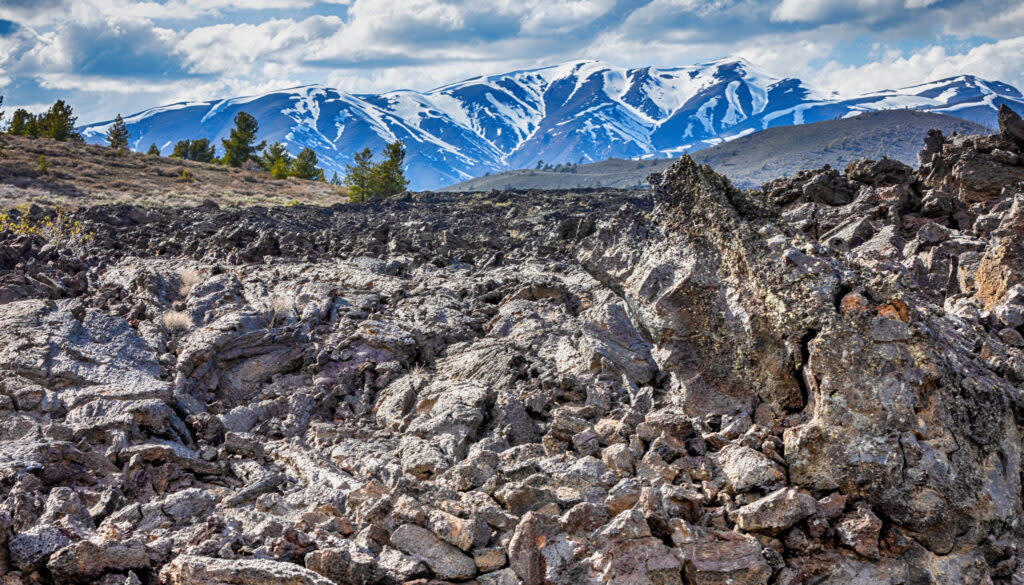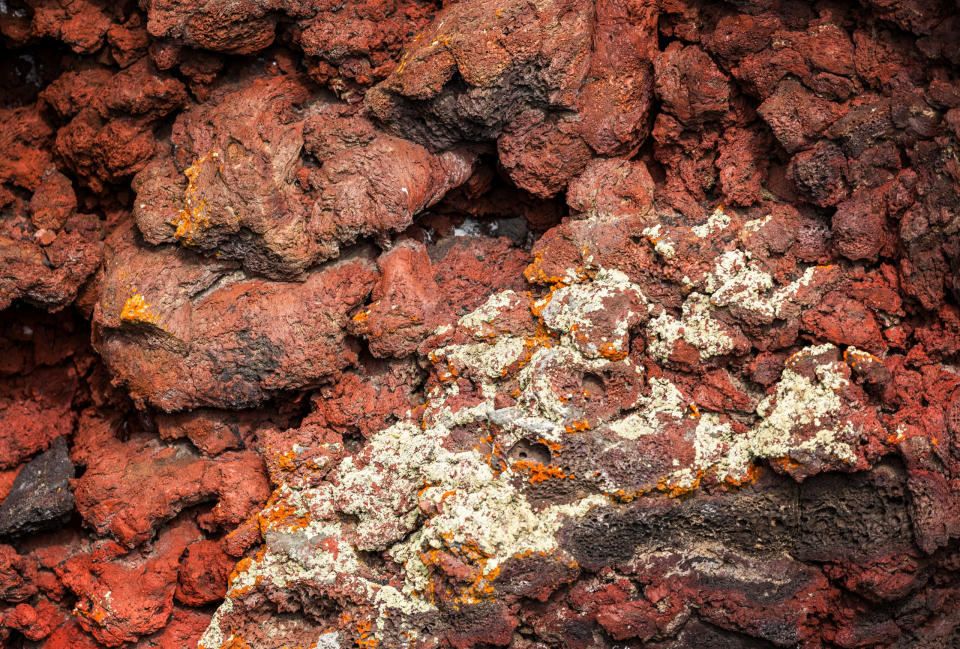What can Idaho’s Craters of the Moon tell us about climate change?

- Oops!Something went wrong.Please try again later.
A lava field can be seen with the Pioneer Mountains in the background on April 29, 2024, at Craters of the Moon National Monument and Preserve near Arco. On May 2, 1924, President Calvin Coolidge designated 54,000 acres of volcanic landscape across southern Idaho a national monument, adding that the landscape has “curious and unusual phenomena of great educational value.” (Pat Sutphin for the Idaho Capital Sun)
In 2016, the U.S. Geological Service conducted a study showing that pikas, small herbivores that typically live in high altitudes in rocky mountain ranges in the West, are disappearing in the Great Basin, southern Utah and northeastern California because of rising temperature and drought.
As scientists examine those disappearances, Idaho’s Craters of the Moon Monument and Preserve has become an important location to better understand how the rodent-like species, and others, are reacting to climate change.
“Craters of the Moon provides a little refuge for them because of the topography, but elsewhere, climate change has actually caused some populations to disappear,” Patrick Gonzalez, a climate change scientist and forest ecologist at the University of California, Berkeley, told the Idaho Capital Sun.
Pikas, which historically were not found in Craters of the Moon, are an example of the toll rising temperatures, wildfires and drought are having on wildlife in the Western United States. Idaho’s volcanic monument serves as an important resource for scientists and the National Park Service to better understand the impacts of climate change.
Interpretive Park Ranger Catherine Orland talks about the environmental impact of climate change on the pika habitat, which the National Park Service identifies on its website as one of the most “enigmatic animals” found at Craters of the Moon. The lava field behind her, filled with A’a formations, is a prime nesting location for pika. Rising temperatures are forcing the pika to relocate because they require colder environments to survive. “For hundreds of miles in any direction, there’s no contiguous habitat for them to find shelter and food,” Orland said. “They’re basically being out-habitated by rising temperatures.” (Pat Suphin for the Idaho Capital Sun)
100 years later, Craters of the Moon remains an icon to Idaho education, economy
On May 2, 1924, President Calvin Coolidge designated 54,000 acres of volcanic landscape across southern Idaho a national monument, adding that the landscape has “curious and unusual phenomena of great educational value.”
A century later, Craters of the Moon has surpassed Coolidge’s expectations. In his proclamation declaring it a monument, Coolidge called its volcanic geology and clear skies “weird and scenic” — features that in 1969 made it a training site for NASA astronauts to prepare for moon exploration, and in 2017 landed it a designation as an International Dark Sky Park.
Celebrating the phases of the Moon
During the months of May through September, officials at Craters of the Moon National Monument will be celebrating and recognizing the fundamental values that have shaped the park over the last 100 years.
The following themes will be highlighted during the Centennial Celebration months:
May – Rich Cultural History
June – Tranquil Wilderness
July – Robust Research
August – Explosive Geology
September – Expansive Night Sky
Check out the Craters of the Moon website for more information about specific events taking place each month.
But before it was designated a national monument and expanded to sit on 738,000 acres of federal land managed by the Bureau of Land Management and National Park Service, the lava fields were home to the ancestors of the Shoshone-Bannock and Paiute Tribes. Archeological records show the Shoshone people spent considerable time at Craters of the Moon, given the presence of sites dating as far back as 8,000 years ago used for hunting, plant gathering and food storage.
Modern tourism to the monument has a significant impact on Idaho’s economy. In 2022, there were nearly 240,000 visitors to the park that spent $9.4 million in neighboring areas while visiting the monument, according to economic data on the National Park Service website.
“Craters of the Moon was initially set aside to protect its superlative volcanic features for general interest, education, and scientific purposes,” Wade Vagias, superintendent of Craters of the Moon National Monument and Preserve, said in a press release. “In addition to these geologic wonders, over the last century, we have discovered that there is so much more to this ‘weird and scenic’ landscape.”
Scientist points to Idaho species most impacted by climate change
And there is so much more to Craters of the Moon, such as the site’s modern role in better understanding the impacts of climate change.
The monument was one of the first sites the National Park Service integrated climate change science into the planning process for its future, Gonzalez said.
Gonzalez, who is a former leading climate change scientist at the National Park Service, told the Idaho Capital Sun the park service established climate change into its park management plan by establishing a Resource Stewardship Strategy in 2018.
The report highlights ways to help park managers protect its natural resources, which Gonzalez said is most threatened by human-caused climate change — or the burning of fossil fuels, deforestation and farming livestock.
“Cars, power plants and deforestation pump twice as much carbon pollution into the atmosphere than forests, soils and oceans can naturally absorb,” he said. “This has increased carbon dioxide to the highest level in two million years and heated temperatures to its highest level in 120,000 years.”
According to the report, some of the main threats to Craters of the Moon related to climate change and its consequences include:
Changes in temperature, leading to shifts in the ranges of plants and animals within Craters of the Moon and increasing wildfires.
Reduction in snowfall and rise in rainfall, resulting in less snow and ice in caves, increasing the risk of flooring and modifying soil moisture.
Extreme storm events, accelerating the deterioration of historic structures, archeology and eroding cinder fields.
Drought conditions impacting plant productivity and tree mortality.
Gonzalez analyzes heated temperatures specific to Craters of the Moon. Since 1950, human-caused climate change has increased spring temperatures in the area by 2.8 degrees Fahrenheit, and summer by 1.6 degrees, “which is a lot,” he said.
Patrick Gonzalez is a climate change scientist and forest ecologist at the University of California, Berkeley. He was a leading climate change scientist for the National Park Service, helping examine the impacts of climate change concerns at Idaho’s Craters of the Moon Monument and Preserve. (Courtesy of Patrick Gonzalez)
“Across the Greater Yellowstone region, which includes Craters of the Moon, research shows that human-caused climate change has reduced spring snowpack to its lowest level in 800 years,” he said. “Research on wildfires shows that human-caused climate change has lengthened the fire season and doubled burned area across the Western United States since 1984.”
Gonzalez said if humans don’t cut carbon pollution and follow guidelines set by the Paris Agreement, an international treaty established in 2015 outlining goals to reduce global emissions, temperatures will continue to increase.
Aside from the pika, animals with the greatest management concern include the greater sage grouse, pygmy rabbit, antelope, and different species of birds and bats. According to the summary, habitat degradation of these species is caused by recreational use, agricultural land use and the infestation of cheatgrass.
The increasing presence of cheatgrass is a top climate concern for monument officials, Gonzalez said. Cheatgrass is an invasive species originating from Europe or Eurasia that was introduced in the U.S. in the mid to late 1800s as a contaminant in seed and straw, according to the USGS. It grows rapidly and in high numbers, making it competitive with native species.
A rise in temperature is beneficial to cheatgrass, as it has high flammability because it absorbs carbon dioxide more efficiently from the air than native grasses and plants, Gonzalez said.
“More cheatgrass means more fire,” he said. “That reduces native sagebrush, which is native and essential for a lot of native species, especially the sage grouse.”
Cars, cattle and climate change solutions
Despite concerns about climate change’s impact on Idaho land, Gonzalez said solutions exist to protect the national monument and its species, such as energy efficiency, renewable energy and public transit.
“There are a lot of negative things I talked about, yet they provide us with incentive to take action on climate change to protect our national parks,” Gonzalez said. “The fundamental issue is halting the burning of coal, methane and other fossil fuels.”
Federal climate goals are aiming to reduce greenhouse gas emissions as the Biden administration has set a goal to cut carbon pollution in half by 2030, and to zero by 2050. Since President Barack Obama and into President Joe Biden’s presidency, renewable energy has doubled in the U.S., cutting coal use in half, and carbon pollution by 17%, Gonzalez said.
Cars and cattle are the top carbon polluters in the United States, so Gonzalez said individuals, like himself, can take steps to minimize their own carbon footprint.
Gonzalez does not have a car, but rather he walks, bikes and takes public transportation. He is also vegetarian.
“A big source of carbon pollution is livestock, because they produce methane in their gut and also producing their feed takes a lot of diesel fuel,” he said. “A global adoption of a meat-free diet would cut our greenhouse gas emissions by 40%.”
However, Gonzalez recognizes the impact that livestock plays a role in Idaho’s economy, and urges people to minimize car usage and meat consumption.
“I know that the economy in Idaho depends on that, but our future also depends on being more sustainable,” he said. “Climate change for me is both professional and personal. I want to demonstrate that this can be done, and I’m doing my part.”
By managing Craters of the Moon, scientists and park service workers can firsthand understand how the Earth’s rising temperatures are impacting Idaho species.
“Craters of the Moon represents a unique ecological heritage for our country and provides us incentives to live more sustainably so that we can protect our national parks from human-caused climate change,” Gonzalez said.
Lichen can be seen on spatter cones on April 29, 2024, at Craters of the Moon National Monument and Preserve near Arco. Lichen is constantly eroding lava rocks. This is what causes the different colors to form on the spatter cones. (Pat Sutphin for the Idaho Capital Sun)
GET THE MORNING HEADLINES DELIVERED TO YOUR INBOX
The post What can Idaho’s Craters of the Moon tell us about climate change? appeared first on Idaho Capital Sun.




